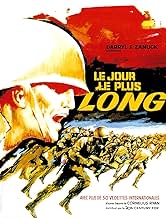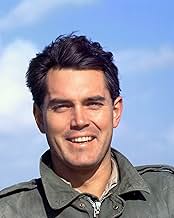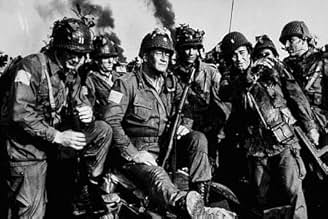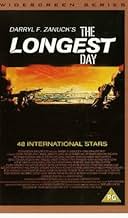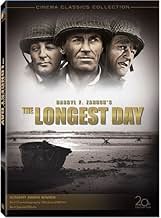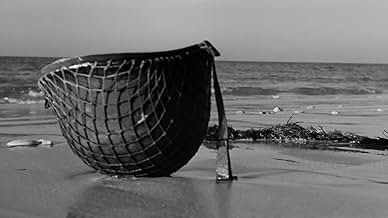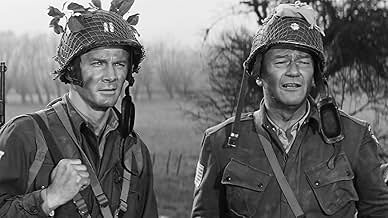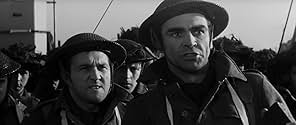AVALIAÇÃO DA IMDb
7,7/10
62 mil
SUA AVALIAÇÃO
Os eventos do Dia D relatados do ponto de vista aliado e do alemão.Os eventos do Dia D relatados do ponto de vista aliado e do alemão.Os eventos do Dia D relatados do ponto de vista aliado e do alemão.
- Ganhou 2 Oscars
- 8 vitórias e 6 indicações no total
Irina Demick
- Janine Boitard
- (as Irina Demich)
Avaliações em destaque
The previous comments about Canadian participation in the Normandy invasion were significant - insofar as there weren't very many. One of the five Normandy beaches was Canadian (Juno), but there is almost no mention of this in The Longest Day, and I'm sure that one would be hard pressed to find many Americans (and not a whole lot more Canadians) who know this. Unfortunately, it is movies such as this and other popular media that shape the historic knowledge of people on both sides of the border. In the near absence of Canadian content, I find it ironic that a young Canadian (Paul Anka) not only played a part in the movie as an American soldier, but also wrote the theme music. I find it also ironic that the legendary rifle used by US soldiers during WW2 and shown in this movie was designed by a Canadian as well (Garand is a French Canadian name). The cruelest irony, of course, is the fact that thousands of Canadian soldiers were maimed or lost there lives on 6 June 1944 and the days thereafter, with virtually no acknowledgement in this movie. I have always enjoyed watching this movie, but it is unfortunate that I must use my imagination to see in it the heroic and selfless wartime effort of my father's generation, in similar fashion to viewers in the US and UK.
THE LONGEST DAY is one of the if not the greatest World War II movie epics. However, it is unfair to compare it to Steven Spielberg's SAVING PRIVATE RYAN. To do so would really be comparing apples and oranges. Spielberg's movie was meant to convey the gore and horror of war and succeeded quite admirably. In THE LONGEST DAY, which was shot in semi-documentary style, Zanuck's intent was to show the monumental effort involved, on the part of the allies, in mounting a successful cross channel invasion. In that regard this film also succeeded quite admirably. It should be regarded more as a history lesson rather than as simply dramatic entertainment. The historical value of the film far outweighs any minor dramatic licenses taken by Zanuck.
This was an another one of these all-star casts that you don't see in more modern times, in which about everyone who was actor made an appearance....or it just seems that way. For those unfamiliar with this film, take a look back on the main page here and check out the famous names in this movie. Click the "more" under the cast overview and you'll see all the names. It's unbelievable. Some of them, to be fair, had very short roles in here, such as Henry Fonda, Rod Steiger and Roddy McDowell, but this is a real "Who's Who" of the acting profession in 1962. There are also a lot of German actors in here speaking German (with subtitles provided), perhaps numbering even more than the English-speaking stars. That's because the famous day of June 6, 1944, is seen from both sides of the conflict.
At three hours, it gives you plenty of D-Day World War II action. Almost two-thirds of the movie involves action from that famous invasion. In some spots, it just gets to be too much. Frankly, the whole film is too much and almost bogs down in too many areas....and it shouldn't, but it is a very technical film. And, for a film 45 years old, the action is pretty realistic. I thought the best shots were the overheads during one particular scenes when the Alies were going through a town.
I am anything but a WWII expert so how much detail of the infamous 'D-Day" here is correct, Since they went into such detail, I'll assume they were fairly accurate. I can't say but this movie educated me on the size of the task. I had no idea "D-Day" was this huge in scope: three million men and 5,000 ships??!!! Amazing.
At three hours, it gives you plenty of D-Day World War II action. Almost two-thirds of the movie involves action from that famous invasion. In some spots, it just gets to be too much. Frankly, the whole film is too much and almost bogs down in too many areas....and it shouldn't, but it is a very technical film. And, for a film 45 years old, the action is pretty realistic. I thought the best shots were the overheads during one particular scenes when the Alies were going through a town.
I am anything but a WWII expert so how much detail of the infamous 'D-Day" here is correct, Since they went into such detail, I'll assume they were fairly accurate. I can't say but this movie educated me on the size of the task. I had no idea "D-Day" was this huge in scope: three million men and 5,000 ships??!!! Amazing.
The Longest Day (1962) - CO-Directors: Ken Annakin & Andrew Morton Everyone knows this was producer Darryl F. Zanuck's baby and it earns its place in cinema history as one of those epic style movies that treats its subject matter with the most serious of attitudes. Obviously a war is no laughing matter but, for better or worse, movies tend to simplify logistics while highlighting emotional chords, such as bravery and homemade apple pie. Zanuck, however, wanted the audience to understand the scope and grandeur of an enterprise like D-Day.
Utilizing a cast of thousands, half of which seemed to be cameo appearances by major stars of the day, Zanuck presents on wide screen all the action and turmoil that surrounded this turning point of WW II. The ever-fighting Republican John Wayne is there, along with Democrat Henry Fonda, tough guy Bob Mitchum, brooding Richard Burton, sexy Sean Connery and pit bullish Rod Steiger. Still for my money, one of the best landing on the beach scenes ever filmed. Sorry Mr.Spielberg. (B&W)
Utilizing a cast of thousands, half of which seemed to be cameo appearances by major stars of the day, Zanuck presents on wide screen all the action and turmoil that surrounded this turning point of WW II. The ever-fighting Republican John Wayne is there, along with Democrat Henry Fonda, tough guy Bob Mitchum, brooding Richard Burton, sexy Sean Connery and pit bullish Rod Steiger. Still for my money, one of the best landing on the beach scenes ever filmed. Sorry Mr.Spielberg. (B&W)
This an important, interesting movie depicting the Overlord operation with monumental logistic and means of effecting the Normandy landing , the most difficult campaign of war . The picture brings to life the famous images of WWII and splendidly the most sensational military operation of the history in an Allied hard-fought effort . The film develops the previous days to the D-Day invasion , such as the landings and the advance over France . The film is magnificently produced in big budget by the great 20th Century Fox producer Darryl F. Zanuck . Evocative cinematography by Jean Bourgoun and catching song by Paul Anka with musical score by Maurice Jarre . Excellent casting by a great plethora of stars . Special mention for John Wayne as Lt. Colonel Benjamin Vandervoort , he's top-notch as a tough , valiant officer in this believable war film and terrific acting by Richard Todd as Major commanding Us paratroopers dropped to protect the flanks of the invasion and taking strategic bridge . Furthermore , known Generals and officers played by prestigious players , as Germans : General Gunther (Curt Jurgens) , Field Marshal Erwin Rommel (Hinz) , Field Marshal Von Rundstedt (Paul Hartmann), and Allied : Brig. General Theodore Roosevelt Jr (Henry Fonda) , Brig. General Norman Cota (Robert Mitchum) , General Haines (Mel Ferrer) , Brig. General James Gavin (Robert Ryan) , General Raymond Barton (Edmond O'Brien), Lt General OMar N Bradley (Stuart) , General Bernard L Montgomery (T. Reid) and General Dwight D. Eisenhower played by Henry Grace . Grace was a famed set designer , while he worked extensively for many films , his only appearance was an uncredited performance as Eisenhower ; despite not being an actor , he was cast for his uncanny resemblance to the General . This famous event from how was orchestrated the dangerous , risky landing maneuvers was professionally directed by a magnificent trio of directors , Ken Annakin , Bernhard Wicki and Andrew Marton.
Adding more details along with the well developed on the movie , the events that happened on June 6, 1944 were the following ones : Shortly after midnight on June 6, about 23.500 US and British paratroopers landed along the edges of the landing beaches . Their mission was to seize vital bridges and communications centers. They also had to hold off any Germans counterattacks until they were relieved by the amphibious forces. The Airbone landings were largely successful. Some US troops missed their target and end up scattered over the countryside. The main amphibious landings took place after an artillery bombardment from some 200 Allied warships at German positions also came under attack from Allied medium and heavy bombers. They were part of the 11,500 aircraft committed to D-Day. They bombed the Germans on and behind the five landing beaches. US troops landed on Utah beach. Strong currents and inaccurate navigation meant that they were a little away from their precise target. They landed about 1 mile (1,6 km) south. The beach there was relatively undefended. The troops soon knocked out the only concrete gun position guarding the beach.Demolitions teams cleared paths through the obstacles the beach and the first tanks crossed the Atlantic Wall. They fanned out into the countryside to link up with the paratroopers. By nightfall of D-Day some 23,000 men and 1,700 vehicles had gone ashore. The beach had been highly congested for much of the day. Utah was a triumph ,however Omaha beach was nearly a disaster, the fight was the most difficult. The Us troops were unable to get off the beach to make room for later waves of invaders. There were better defenses there than on the other beaches, and the German defenders were positioned on high ground, from where they could pour fire down on the attackers.The allies also made mistakes. The naval bombardment ended too soon, and the bombers missed their targets and launched landing crafts and amphibious tanks too far out from the beach, may were sunk. When the first assault wave landed ,it faced a bar-rage of fire , some men were thinking of evacuation. However small groups began to make it off the beach to the high ground beyond. By dusk, some men were ashore, most were still crowed on the beach. The high ground beyond was only thinly held by exhausted survivors waves. Some 2300 US troops had been killed in the landings. The operation had come close to disaster. The three Anglo-Canadian beaches-Gold, Sword and Juno stretched fore some 25 miles. They were wide and open and ideal for amphibious landings. The British on Gold and Sword quickly crashed though the Atlantic wall. Their success was due partly to a range of specially developed armored vehicles known as Funnies. The Canadians at Juno had a tougher time. They faced rough seas and alert defenders .By late morning ,they were also pushing inland. Despite the horror of beaches , overall Allied losses were far lower than expected. Some 6000 US personnel were killed, wounded, or missing, along with 4300 British and Canadian troops. German losses totaled between 4000 and 8000. By the day's end ,some 128000 Allied soldiers were ashore and many more were on their way.
Adding more details along with the well developed on the movie , the events that happened on June 6, 1944 were the following ones : Shortly after midnight on June 6, about 23.500 US and British paratroopers landed along the edges of the landing beaches . Their mission was to seize vital bridges and communications centers. They also had to hold off any Germans counterattacks until they were relieved by the amphibious forces. The Airbone landings were largely successful. Some US troops missed their target and end up scattered over the countryside. The main amphibious landings took place after an artillery bombardment from some 200 Allied warships at German positions also came under attack from Allied medium and heavy bombers. They were part of the 11,500 aircraft committed to D-Day. They bombed the Germans on and behind the five landing beaches. US troops landed on Utah beach. Strong currents and inaccurate navigation meant that they were a little away from their precise target. They landed about 1 mile (1,6 km) south. The beach there was relatively undefended. The troops soon knocked out the only concrete gun position guarding the beach.Demolitions teams cleared paths through the obstacles the beach and the first tanks crossed the Atlantic Wall. They fanned out into the countryside to link up with the paratroopers. By nightfall of D-Day some 23,000 men and 1,700 vehicles had gone ashore. The beach had been highly congested for much of the day. Utah was a triumph ,however Omaha beach was nearly a disaster, the fight was the most difficult. The Us troops were unable to get off the beach to make room for later waves of invaders. There were better defenses there than on the other beaches, and the German defenders were positioned on high ground, from where they could pour fire down on the attackers.The allies also made mistakes. The naval bombardment ended too soon, and the bombers missed their targets and launched landing crafts and amphibious tanks too far out from the beach, may were sunk. When the first assault wave landed ,it faced a bar-rage of fire , some men were thinking of evacuation. However small groups began to make it off the beach to the high ground beyond. By dusk, some men were ashore, most were still crowed on the beach. The high ground beyond was only thinly held by exhausted survivors waves. Some 2300 US troops had been killed in the landings. The operation had come close to disaster. The three Anglo-Canadian beaches-Gold, Sword and Juno stretched fore some 25 miles. They were wide and open and ideal for amphibious landings. The British on Gold and Sword quickly crashed though the Atlantic wall. Their success was due partly to a range of specially developed armored vehicles known as Funnies. The Canadians at Juno had a tougher time. They faced rough seas and alert defenders .By late morning ,they were also pushing inland. Despite the horror of beaches , overall Allied losses were far lower than expected. Some 6000 US personnel were killed, wounded, or missing, along with 4300 British and Canadian troops. German losses totaled between 4000 and 8000. By the day's end ,some 128000 Allied soldiers were ashore and many more were on their way.
Você sabia?
- CuriosidadesWhile clearing a section of the Normandy beach near Pointe du Hoc, the crew unearthed a tank that had been buried in the sand since the original invasion. Mechanics cleaned it off, fixed it up and it was used in the movie as part of the British tank regiment.
- Erros de gravaçãoA compound fracture of the ankle indicates blood and/or protruding bones, of which Vandervoort's ankle had none. It also would have been impossible to put any weight on the ankle.
- Citações
Flight Officer David Campbell: The thing that's always worried me about being one of the few is the way we keep on getting fewer.
- Cenas durante ou pós-créditosThere is a 20-second overture on a black screen, no 20th Century Fox logo (in spite of this being one of their most expensive productions), and a six-minute cold open before the title is displayed. Apart from the title, there are no credits at the beginning of the film. All cast and crew credits are at the end of the film.
- Versões alternativasSome video copies omits Jean Servais scenes as a Free French admiral making a short speech to his crew before the shore bombardments starts.
- ConexõesEdited into All This and World War II (1976)
Principais escolhas
Faça login para avaliar e ver a lista de recomendações personalizadas
Detalhes
- Data de lançamento
- País de origem
- Central de atendimento oficial
- Idiomas
- Também conhecido como
- El día más largo del siglo
- Locações de filme
- Sainte-Mère-Eglise, Manche, França(parachutists landing in the village)
- Empresa de produção
- Consulte mais créditos da empresa na IMDbPro
Bilheteria
- Orçamento
- US$ 10.000.000 (estimativa)
- Tempo de duração
- 2 h 58 min(178 min)
- Cor
- Black and White(original version)
- Proporção
- 2.35 : 1
Contribua para esta página
Sugerir uma alteração ou adicionar conteúdo ausente


